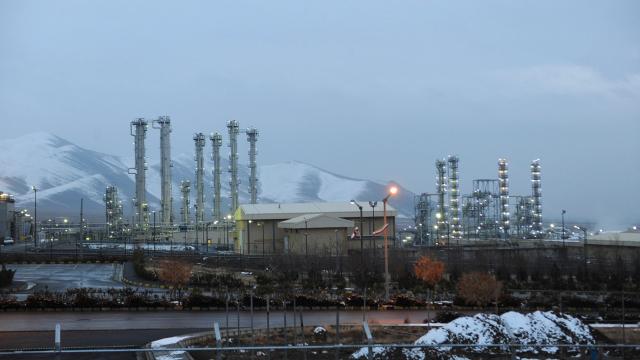Iran’s Atomic Energy Organisation said on Monday that it has increased production of low-enriched uranium—of the type suitable for use in nuclear power generators, but not nuclear warheads—to levels that will exceed limits imposed in the 2015 nuclear deal between Iran and other world powers by June 27, the New York Times reported on Monday.
According to the Times, Iranian officials said that it would breach the limits on its stockpiles of low-enriched uranium unless European countries agreed to help the nation reduce the impact of U.S. sanctions that have wreaked havoc on its economy.
The Guardian noted they also floated the idea of enriching the uranium to a higher level of up to 20 per cent starting on July 7.
The threats come as Donald Trump’s administration has accused Iran of being behind explosions on oil tankers passing through Gulf of Oman, as well as deployed 1000 additional troops to the Mideast.
They also follow a year in which Iran complied with the terms of the nuclear deal, despite Trump’s very public decision in May 2018 to abandon it. There is also widespread scepticism among European allies (and many in the U.S.) that Iran may not be responsible for the tanker attacks and the White House is trying to cook up an Iraq War-style rationale for regime change.
Trump’s national security adviser, John Bolton, is a well-known advocate of bombing Iran.
As of Wednesday, only the UK has said it believes the White House’s evidence, which has included photos of what the Pentagon claims is Islamic Revolutionary Guard Corps (IRGC) removing a limpet mine from one of the tanker’s hulls.
Uranium mined from the Earth is composed of two isotopes: U-238 and U-235. Almost all of that is U-238, which is non-fissile, but it can be steadily enriched into U-235, which is fissile. (Iran uses centrifuges for this purpose.)
According to Reuters, the 2015 deal limits Iran’s stockpiles of enriched uranium to around 300kg enriched to 3.67 per cent, which is the limit that Iran said it will break by June 27.
Uranium enriched to more than 20 per cent U-235 is considered highly enriched, though 90 per cent is typically considered the minimum necessary for the kind of miniaturised nuclear weaponry that could be delivered by a missile.
Enriching uranium to 20 per cent, as Iran suggested it may do in the future on Monday, would arguably be more provocative than breaching the limits on low-enriched uranium.
Iran has never built a nuclear weapon, and it hasn’t officially stated any intention to build one, though the 2015 agreement was designed to prevent further uranium enrichment that could accelerate the timetable for it to obtain one.
According to the Times, Institute for Science and International Security President David Albright estimated last year that it would take Iran eight to ten months to enrich fuel to the level necessary to build a nuke.
But estimates of how long it would actually need to build the nuclear weapon itself (which requires an understanding of advanced technologies including the warhead itself and the missile it would be mounted on) are considerably murkier, with estimates ranging from months to far longer.
As the Times separately noted, the current consensus among most experts is that such a weapon would be “significantly longer” than a year away.
According to the Guardian, Iran’s Atomic Energy Organisation spokesman Behrouz Kamalvandi portrayed the decision as necessary for civilian purposes, including 5 per cent enrichment for a plant in Bushehr and 20 per cent enrichment for a Tehran research reactor.
Kamalvandi told reporters that Iran’s “move will be reversed once other parties fulfil their commitments,” but also said that the country could reconfigure its Arak heavy water nuclear reactor, which Iran said it had disabled in 2016.
As the Guardian noted, Kamalvandi’s “formulation did not amount to a firm commitment to reach 20% levels.”
Kamalvandi added that Iran would break a 130-tonne limit from the 2015 deal on heavy water byproducts at the Arak facility within two and a half months, though only if it could not find a client to purchase them, according to the Guardian.
The Arak facility could also potentially be rebuilt in a manner that would allow it to produce weapons-grade plutonium, though the Times reported in 2015 that experts say “the military threat from an unfinished plutonium complex can be viewed as abstract compared with Iran’s success at purifying uranium in its two underground plants.”
According to the Times, European leaders largely put the blame on Trump for provoking Iran into abandoning the deal, while Iran believes that few countries would possibly be reckless enough to ally with the U.S. in another potentially disastrous military intervention in the Middle East and that Trump is bluffing: “It is a huge game of chicken, and a miscalculation on either side could easily provoke a conflict.”
